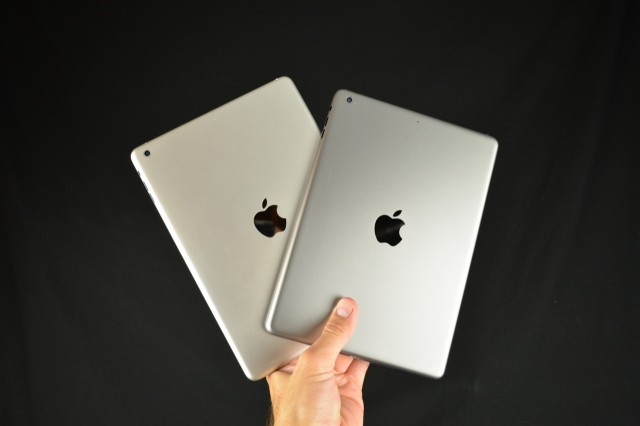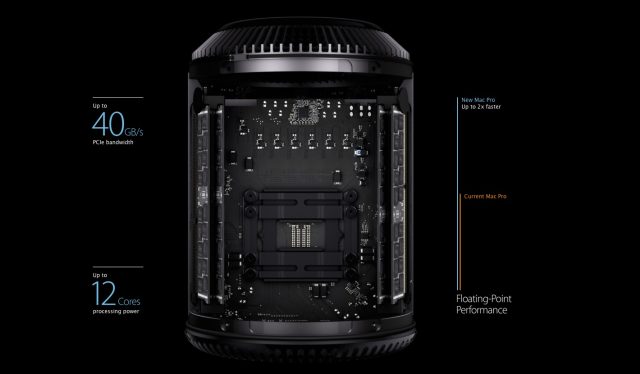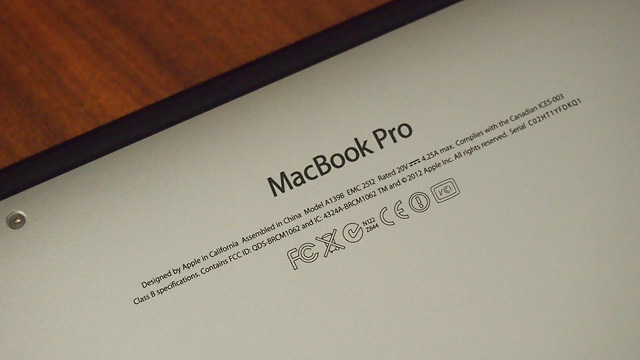
The invitations for Apple's October 22 media event say that the company still has "a lot to cover," and that's no exaggeration. We got two new iPhones and new iMacs in September, but a big chunk of Apple's product lineup is still due for its customary yearly refresh.
We don't like to cover each and every poorly sourced story that the rumor mill spits out, but we've taken a look at the current scuttlebutt to tell you what you're likely to see when Tim Cook takes the stage on Tuesday. Settle in, because it's a long list.
The iPad and iPad mini

First on the docket are new versions of both of Apple's tablets, the iPad and iPad mini. This year, each tablet is expected to borrow features from the other.
The larger iPad should pick up a number of iPad mini-inspired design cues, most notably its narrower display bezel, its stereo speaker grilles, and its slimmer profile. Recent, credible-looking part leaks show off both silver and "space grey" versions of the tablet's new design, albeit without any of the internals installed. The new design would be the first substantial change to the look and feel of the full-size iPad since the iPad 2 was released in 2011.
We've heard less about the tablet's insides, but past precedent suggests that it will include an A7X chip that combines the two 64-bit CPU cores from the A7 with a more powerful (but architecturally similar) GPU and a wider memory interface. Apple has been shipping all of its high-end iOS devices with 1GB of RAM for a little over a year now, so expect the new iPad to include at least that much memory—in fact, even an upgrade to 2GB doesn't seem entirely out of the question (remember that the third-generation iPad went to 1GB of RAM before the iPhone line did). Pricing and internal storage will probably stay the same—current iPads include 16GB, 32GB, 64GB, or 128GB of storage and start at $499.
The iPad mini stands a pretty good chance of inheriting the large iPad's 2048×1536 Retina display, though the rumor mill has flip-flopped on this one quite a bit. Some reports have suggested that the Retina mini won't happen at all this year, while others have said that a Retina screen will come to higher-end models, but entry-level tablets will still come with non-Retina displays. Examination of Apple's supply chain by AppleInsider suggests that some models of the original iPad mini could continue on as entry-level models after the newer version is introduced. If Apple does continue to sell a non-Retina iPad mini alongside a Retina version, we think keeping the old version is more in line with Apple's usual strategy than a brand-new non-Retina tablet. Bringing in two new iPad minis at once would make software support that much more difficult for Apple and its software developers, and the current iPad mini already supports most of iOS 7's banner features (Siri and AirDrop are two big ones that some older hardware doesn't have).
If the iPad mini does pick up that Retina display, it has been suggested that the tablet may be subtly thicker and heavier than last year's model to accommodate the screen and the larger battery required to power it. The first full-size Retina iPads did exactly the same thing, retaining the iPad 2's basic look and feel but getting just a little bulkier out of necessity. We're not sure what chip would power a theoretical Retina mini, but as we noted in our iPhone 5S review, the GPU performance of the A7 is actually a little higher than the A6X that powers the fourth-generation iPad. Apple likes to re-use components where it can, so transplanting the A7 and its 1GB of RAM from the iPhone to the iPad mini wouldn't be a surprise. The current mini runs Apple's competent-but-aging A5 SoC, so an A7 or even some kind of new A6 or A6X variant would be a big upgrade.
The last iPads were released the second Friday after their announcement, which was also the case for the most recent iPhones. It's not a sure thing, but Apple's past behavior is a good predictor of its future behavior—November 1 is the launch date to pick in the office pool. Finally, expect the old iPad 2 to quietly disappear from the lineup.
Mavericks

iPads are going to be the main focus at the event, but Apple introduced several new Macs at last October's iPad event, and we expect the same thing this year.
We'll begin with the software: OS X 10.9 was unveiled in June at Apple's Worldwide Developers Conference (WWDC), and we already have a pretty good idea of what it brings to the table. Power-user features (including substantial and much-needed changes to multi-monitor support), energy- and resource-saving enhancements, and the continued death of skeuomorphism will all make Mavericks a nice improvement to Mountain Lion. We also know that any Mac that can run OS X 10.8 will be able to upgrade to 10.9.
Apple issued a Golden Master build of Mavericks to developers weeks ago, so all we're really waiting for here is a release date and pricing information. We'd expect Mavericks to go live in the Mac App Store at any point between the October 22nd event and the end of the month, accompanied by an updated version of the OS X Server add-on.
Mac Pro

Like Mavericks, Apple took the wraps off of the new Mac Pro at WWDC, so we already know to expect a powerful and unique but less upgradeable professional computer. The new systems will come with big Ivy Bridge Xeon CPUs from Intel (with up to 12 cores), 1866MHz DDR3 RAM, PCI Express SSD slots, and new Thunderbolt 2 ports in addition to the new cylindrical design.
Apple said at WWDC that we'd know the Mac Pro's pricing and availability information in the fall, so it doesn't technically need to tell us anything else about the system before December 21. Still, given the imminent launch of Mavericks and strong interest in the computer from people who have been waiting for this upgrade since 2010, the timing seems right. We'd be surprised not to hear about a launch date on Tuesday, even if the system doesn't ship until a few weeks later (as happened with the 2012 iMacs).
MacBook Pros

That leads us to Apple's other "professional" Macs, the Retina MacBook Pros. Apple introduced the 15-inch and 13-inch models separately last year, but we expect both to be updated simultaneously this year. They're both likely to follow the same template as the 2013 MacBook Air: the same screen and chassis as the current models, but with Intel's Haswell CPUs, 802.11ac, PCI Express SSDs, and improved battery life. The new MacBook Pros could pick up Thunderbolt 2 ports, too.
The wild card in these new systems is the GPU, at least in the 15-inch model. Apple could choose to increase performance over the 2012 model by sticking in a new dedicated GPU from AMD or Nvidia, or it could choose to use one of Intel's high-end Iris 5200 integrated GPUs. Based on what we saw in the 2013 iMac, the Iris GPU would keep performance roughly the same (or even decrease it slightly) compared to the current model, but it would also take up less space on the computer's motherboard and reduce power usage compared to a dedicated GPU. The 13-inch model is more likely to go with the Iris 5100 GPU, which is somewhat faster than the HD 5000 used in the MacBook Airs but lacks the 128MB of eDRAM that helps the Iris 5200 perform as well as it does.
In any case, expect the 15-inch model to continue using quad-core CPUs while the 13-inch model sticks with dual-core CPUs (much faster ones than in the Airs, but dual-core nonetheless). Intel's ARK product pages list several CPUs that would be ideal for next-generation MacBook Pros with integrated graphics—this one (or one like it) could work for the 15-inch model and this one for the 13-inch.
Finally, let's talk about the non-Retina MacBook Pros that are still hanging around. There are two likely courses of action here: Apple quietly refreshes them (or even keeps them on Ivy Bridge) and continues to sell them alongside the Retina Macs as entry-level models, or Apple lowers the prices of the Retina computers a bit and sends the old Pros off into the sunset. Optical drives and rotational hard disks make the non-Retina laptops anachronisms in Apple's mobile lineup, so we're hoping the company goes with option two.
And the rest
A few of Apple's other products are theoretically due for an update—of these, we think a quiet Haswell bump for the Mac mini is the most likely, though this could be done offstage like the 2013 iMac introduction. The iPods didn't get refreshed back in September, but Apple seems to have settled into an every-other-year update cycle for its media players; an update now seems unlikely. Apple could put out a new Apple TV box, though the current model's design was just tweaked back in March. Barring the introduction of a developer API or some other substantial change to Apple's present Apple TV strategy, the set-top box is already as powerful as it really needs to be.
Finally, we could always see something that's more than just the latest iteration of one of Apple's existing product lines—hope springs eternal, and some analysts will never stop chasing big dreams of iWatches and Apple televisions.
If you're hoping for something all new, here are two points to consider: Apple isn't great at controlling leaks from its supply chain, so if something new was in mass production right now it's near-certain that we'd already be seeing the customary part leaks and repeated, insistent reports from "people familiar with the matter." That said, consider the June announcement of the Mac Pro—Apple was clearly developing the computer, but wasn't yet producing it in large numbers, and in those cases the company can still keep a secret. Apple has enough stuff to fill an entire event without a brand new product, but if it does unveil something new we wouldn't expect it to come to market just yet.
Whatever Apple announces, Ars will be there on the ground on Tuesday morning at 10:00 PDT to liveblog the proceedings and get some hands-on time with the new stuff. Our customary in-depth reviews will follow in the days and weeks afterward.
Listing image by sonnydickson.com
reader comments
77